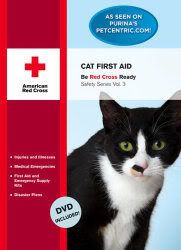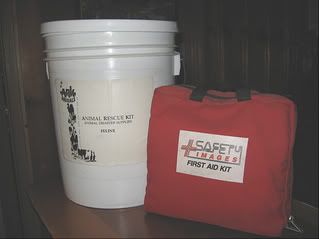 First Aid books for pets have been slow in surfacing. Long overdue, the American Red Cross has partnered with StayWell Publishing to finally release a Cat First Aid book.
First Aid books for pets have been slow in surfacing. Long overdue, the American Red Cross has partnered with StayWell Publishing to finally release a Cat First Aid book.
I discovered the book project while talking about disaster rescue in Las Vegas, Nevada. In fact, it was the Las Vegas Chapter of the Red Cross who was promoting the book but I heard about it from a radio host at a large pet industry event.
This Cat First Aid book is a very basic guide and is part of a safety series.
Books in the American Red Cross Safety Series include:
Dog First Aid, Cat First Aid, Family Caregiving, A Family Guide to First Aid & Emergency Preparedness, and First Aid & Safety of Babies & Children.
The Cat First Aid book comes with an instructional compact disk that contains a few highlighted sections to show some of the techniques cat owners can use to assist their injured feline.
Cat owners learn the ABCs of cat first aid:
- Airway
- Breathing
- Circulation
The Cat First Aid book is broken into seven chapters:
Protect Your Cat’s Health
This is a basic section about maintaining a health cat. It makes suggestions for veterinary wellness exams, diet, exercise, grooming, spaying or neutering, and identification tags.
Identification tags are something I really try to motivate pet parents to use—even when pets are indoors. So, I was happy they were included in this section along with tattoos and microchips. However, their resources links could have been better for finding a lost pet.
I would have also liked to see socialization and early training section talking about kitten kindergarten classes since these are important schooling techniques for any pet.
The piece about on traveling with your pet in this section encouraged people to get carriers and added very basic tips for car or plane trips. Please, please, please get a carrier!
Again, I’d like to have seen some good online references as there are some good ones that exist.
Giving Your Cat Medications
This section discusses giving eye, ear, and topical medication as well as how to pill a cat. I really encourage most people to use the pill wands but this is only mentioned as pill “guns.” Elizabethan collars and risks posed by human food and medicines round out this section.
Be Prepared
Perhaps this is covered in other publications (like my Animal Disaster Preparedness Guide) but I would have liked to have seen the other groups that specialize in animal disaster rescue listed as resources.
As it stands, it urges people to make a cat first aid kit and to prepare for a disaster by offering some tips of what needs to be included in the evacuation kit and what plans to take.
Since the Red Cross deals with disaster I was disappointed this section was a mere 4.5 pages long which illustrates just how much more work needs to be done on encouraging animal disaster preparedness.
How To Know If It’s A Medical Emergency
The picture of the person holding up the tail of a sitting cat and inserting the thermometer made me laugh and say, “In what universe?”
Other than that, the basics of this section teach cat owners what is normal for a feline and how to do basic exams to verify what is standard for their pet. It describes taking the body temperature, checking breathing, and monitoring circulation.
It might be better to instruct people how to do a sampling technique instead of monitoring for a full minute (take fifteen seconds and then multiple the amount of breaths by four) but then this is a very basic instruction manual and I bet the consistency of standards works.
Capture techniques are discussed and I liked how the section touched on a variety of options. Personally I like the “burrito” method of cat restraint and wish they would have shown this more secure procedure for toweling a cat. It does briefly cover how to prepare for shock and gives cat owners bullet points that highlight just what constitutes emergency conditions.
I would have liked to see a discussion about how to determine when something is wrong with your cat. Early warning signs might urge people to catch something early. Activity level changes, abnormal eating and drinking patterns, visibility of the nictating membrane (commonly called a third eyelid), dull coat, or weight loss are topics I think might be useful in this work.
Cat Vital Signs
Heart Rate: 160-220 beats per minute.
Normal breathing rate: 20-30 breaths per minute.
Normal body temperature: 100-102.5 F
Respond to a Breathing or Heart Emergency
Another super short section, this addresses cardiopulmonary resuscitation, airway, and choking issues.
The video uses a nasty looking cat mannequin placed on a counter top to illustrate technique. The same model makes its appearance again in the car accident video.
The CPR chart is probably what most people will look at. I’ve never had to administer this technique and would have liked to see some real life footage of application instead of staged video.
Last year many fire stations were given air masks for pets and I am wondering how helpful these types of tools would be.
First Aid Reference Guide
This is the main portion of the Cat First Aid Guide. The issues are listed alphabetically. I would have liked to see more pet owner type references and thought that constipation and urinary accidents or incontinence might be better cross referenced to each other.
The section is seventy-six pages long and has some surprising entries. The dystocia (birthing emergencies) actually lists the stages of birth and discusses common birthing problems and details signs and symptoms. I liked that it warned that most cats will stop labor if they are disturbed.
Bite wounds and bleeding, fishhook injuries (which I mostly see in dogs), parasitic disease, shock and strangulation are just a few selected entries. Flipping through the book you can see the first aid topics listed at the top of the page which makes them easy to find.
It would be good to add something on sudden changes or weight loss. Many pet owners don’t get their animals to the veterinarian soon enough—and when they do the problem is usually pretty advanced.
I would have also liked to see spiders included in the venomous bit section but was glad to find signs and symptoms for the snakes, scorpions, and toads along with a bolded “What You Can Do of Value.”
The big gross out in this section? The proptosis (eye out of socket) photo. (Do you think more trauma photos would help you better prepare?)
Another feature I liked was the few side bar tips that popped up here and there. One highlighted propylene glycol (animal friendly antifreeze) and over the counter dangers such as ibuprofen.
When it is Time to Say Goodbye
This section should have been dumped or expanded. The one page Euthanasia summary begins:
When your gut starts telling you, “It is time,” talk to your veterinarian about the appropriate next step.
The section ends with a two resources for pet loss.
I believe people need more guidance on this issue. How do they determine when it is time? What are the agencies you call to dispose of the bodies of those hit by cars? How do you locate a pet chaplain or pet funeral home? What choices do you have for cremation?
Pet hospice and other services now exist to help people move through pet loss but it has not hit mainstream yet. Personally, I’d like to see a resource listing that is more comprehensive than now exists on this one page.
Compact Disk
A nice feature is that this book comes with a demonstration video. I think it is on the right track. However, the video contains the most tranquil feline animal actors I’ve ever seen!
So, I wonder how many average pet owners will question their skills when presented with the same challenges and their uncooperative critter or an animal that is reacting to his or her pain.
I didn’t like the subtitles on the video. They are automatic and it would have been nice to shut them off.
Cat First Aid Compact Disk Contents
- Introduction
- What’s Normal for My Cat
- Restraint
- ABCs & Rescue Breathing
- Choking
- Shock
- Abrasions, Cuts and Tears, and Pad Wounds
- Eye Injuries
- Fractures
- Car Accidents
- Animal Bites and Abscesses
- Burns
- Electrical Shock and Burns
- Heat Exhaustion and Heat Stroke
- Hypothermia/Frostbite
- Poisoning
- Urinary Blockages
- Closing
Overall I think the Cat First Aid book and CD is a good start to helping feline pet parents get onto the right track. Most people do not know how to address minor issues with their pets nor do they know how to determine when something is serious.
I think it would be a good idea to also include an order form for some of the supplies that might be useful to purchase from the Red Cross. They do include a resource page with the link but a phone number and list would be great for those without access. The rumor is that they will also be releasing a Pet Disaster Emergency Kit this year but I have not seen it yet.
So, if you need a guide I’d say buy the Cat First Aid Now.


